Inside The New York Botanical Garden
Chile
Posted in Bill Buck, From the Field, Science on February 14 2011, by William R. Buck
Ed. note: NYBG scientist and Mary Flagler Cary Curator of Botany, Bill Buck is currently on expedition to the islands off Cape Horn, the southernmost point in South America, to study mosses and lichens. Follow his journeys on Plant Talk.

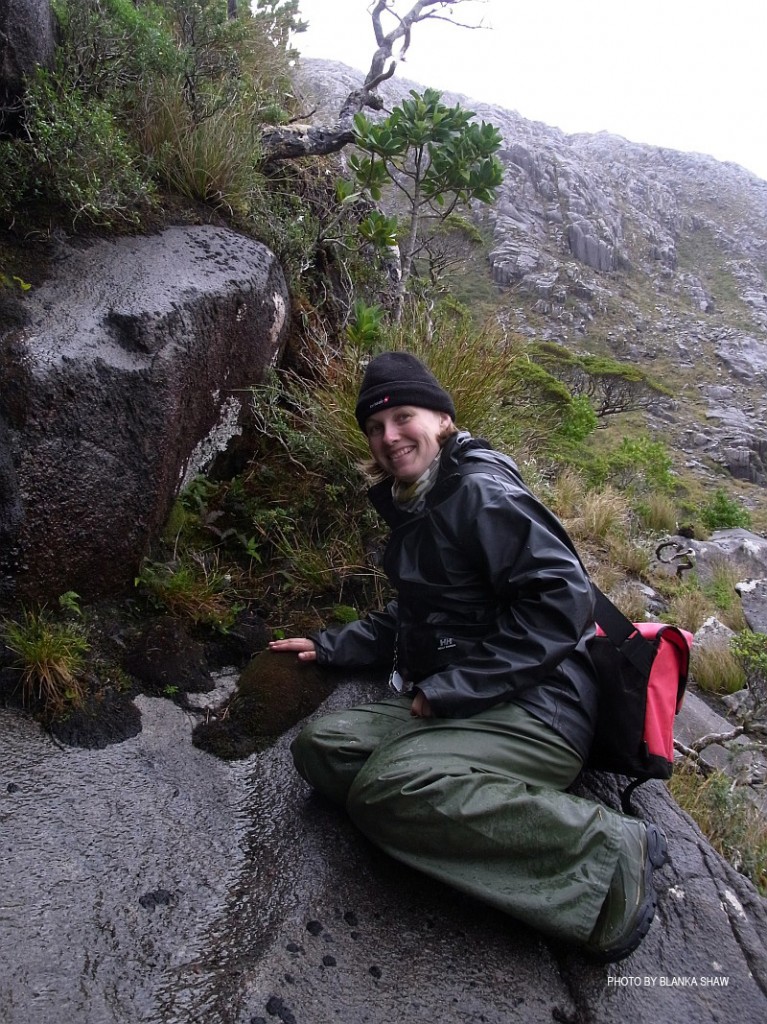 February 8, 2011; Punta Arenas, Chile; final entry
February 8, 2011; Punta Arenas, Chile; final entry
On the morning of February 6, we arrived in Seno Término, an appropriate name for our last day in the field. The weather mirrored our reluctance to finish such an amazing expedition. The skies were heavily overcast and a constant light rain fell. It seemed reasonable that our last day in the field would be a wet one, like so many before it. Seno Término runs, more or less, east-west, meaning that where we anchored was quite choppy. Across the sound, where there was a less substantial barrier to the wind, sheets of rain flew by one after another.
Despite (or maybe because of) the weather, no one wanted to stay out of the field today. I chose a small band of forest at the base of a granite mountain; at least in the forest the wind is much less. Time zoomed by as I worked back and forth through the forest, reaching and ascending the lower parts of the mountain whenever I could. Even at this late date, with so many sites under our belts, interesting mosses continue to be found. I realized that here, on this last day, I had finally gotten in shape so that climbing a hill didn’t make me out of breath. Talk about a day late and a dollar short!
At lunchtime we moved to our final collecting site, Seno Ocasión, opposite Isla Aguirre, where we had visited earlier. The cold rain persisted, but what was really dampening our spirits was the realization that our expedition was all but over. 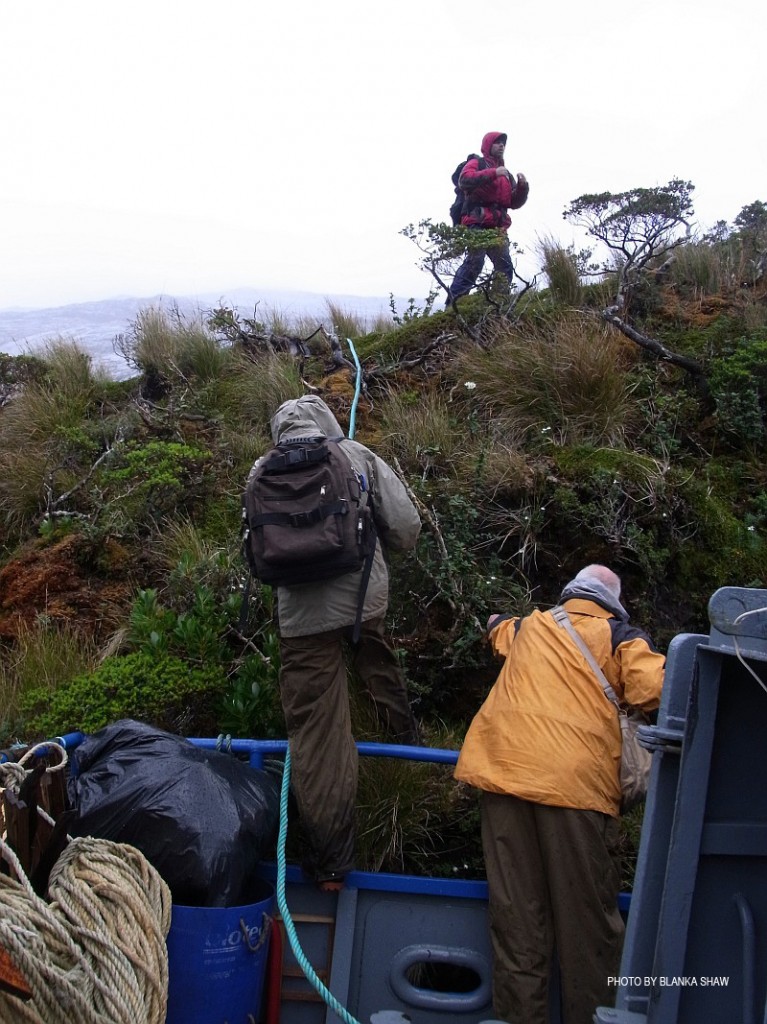 The ship was tied to a rock wall and we were able to just jump ashore and begin our collecting. The destination-oriented collectors ran ahead in an attempt to reach a nearby rocky peak. Apparently in these exposed areas the wind was fierce and prevented much progress. On the other hand, Kimmy and I hadn’t made it far from the ship when I spotted a steep ravine that ran right down the sea (which the others had run past). It was wet and slippery, but it’s always harder going down than climbing up, so we decided to chance it. At times I had to remove my collecting pack and leave it behind in order to fit onto narrow ledges that I wanted to access. In the end my efforts were rewarded with a moss no one on our ship recognized. Having to crawl backwards to get off the ledge was a small price to pay.
The ship was tied to a rock wall and we were able to just jump ashore and begin our collecting. The destination-oriented collectors ran ahead in an attempt to reach a nearby rocky peak. Apparently in these exposed areas the wind was fierce and prevented much progress. On the other hand, Kimmy and I hadn’t made it far from the ship when I spotted a steep ravine that ran right down the sea (which the others had run past). It was wet and slippery, but it’s always harder going down than climbing up, so we decided to chance it. At times I had to remove my collecting pack and leave it behind in order to fit onto narrow ledges that I wanted to access. In the end my efforts were rewarded with a moss no one on our ship recognized. Having to crawl backwards to get off the ledge was a small price to pay.
Every great journey must end. But, there's always next year! More below.
Posted in Bill Buck, From the Field, Science on February 13 2011, by William R. Buck
Ed. note: NYBG scientist and Mary Flagler Cary Curator of Botany, Bill Buck is currently on expedition to the islands off Cape Horn, the southernmost point in South America, to study mosses and lichens. Follow his journeys on Plant Talk.
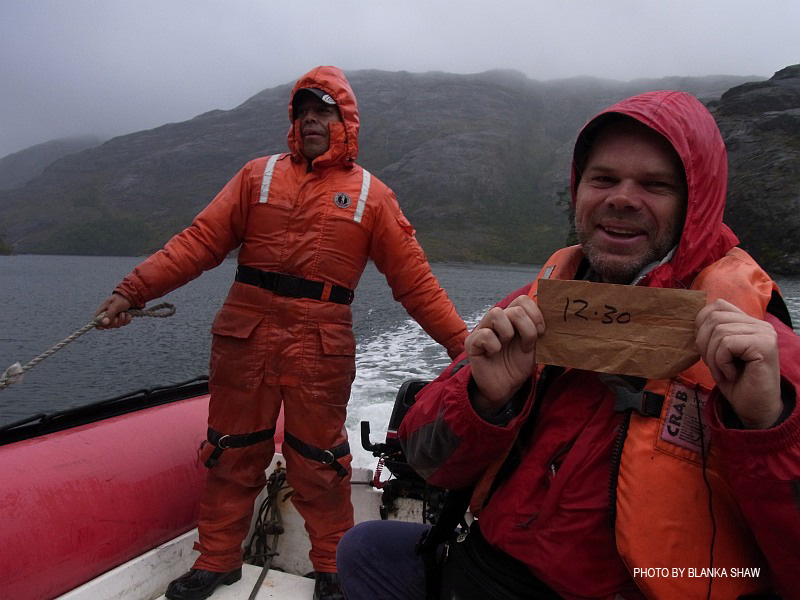 February 5, 2011; unnamed sound northwest of Isla Georgiana, 54°35’S, 71°49’W
February 5, 2011; unnamed sound northwest of Isla Georgiana, 54°35’S, 71°49’W
As we awoke in Seno Aragay, at the isthmus of the Brecknock Peninsula, a steady, cold rain fell. At least it wasn’t windy.
After a hot breakfast of freshly fried bread, we suited up in our rain gear and headed into the field. Due to the weather we decided three hours in the morning would be about all we could tolerate. Jim and Matt headed in one direction while Blanka and I headed in another. As I came to the summit of a rise I saw Juan and Kimmy being dropped off near the base of a waterfall. As I wandered over the terrain, I desolately picked up the standard mosses just to document their distribution. I got wetter and wetter and colder. On this next to the last day in the field, as we get nearer and nearer to heading home, it was proving hard to get up much enthusiasm as my hand-lens became useless as it was constantly fogged up. When I realized I still had almost two hours left before being picked up, I headed to the base of a dripping cliff.
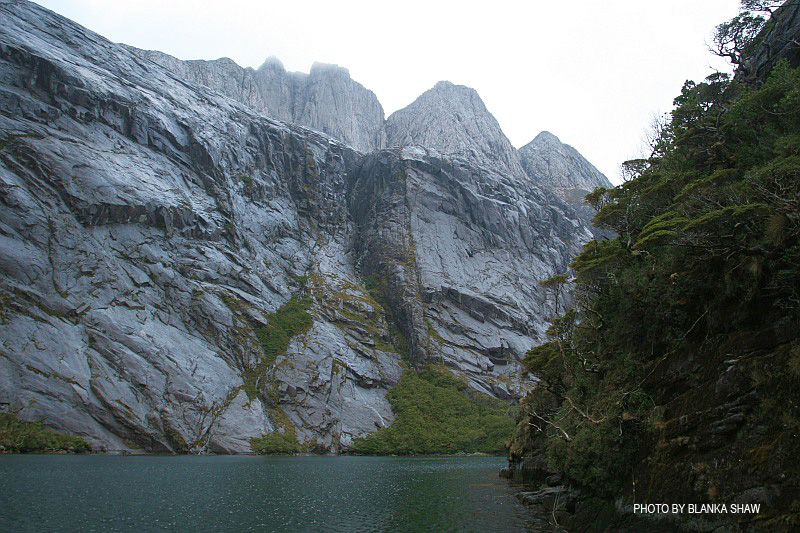 Upon arriving there, in no time at all I completely forgot about being cold and wet. Instead I was focused on the mosses that grew in sheltered areas under rock overhangs. Here they get less rain (even though, in addition to the rain I was continuously being dripped on from the water running off the cliff) and so i found a completely different suite of species. A couple of these were ones I had not seen before on this trip and I became completely oblivious to my physical discomforts.
Upon arriving there, in no time at all I completely forgot about being cold and wet. Instead I was focused on the mosses that grew in sheltered areas under rock overhangs. Here they get less rain (even though, in addition to the rain I was continuously being dripped on from the water running off the cliff) and so i found a completely different suite of species. A couple of these were ones I had not seen before on this trip and I became completely oblivious to my physical discomforts.
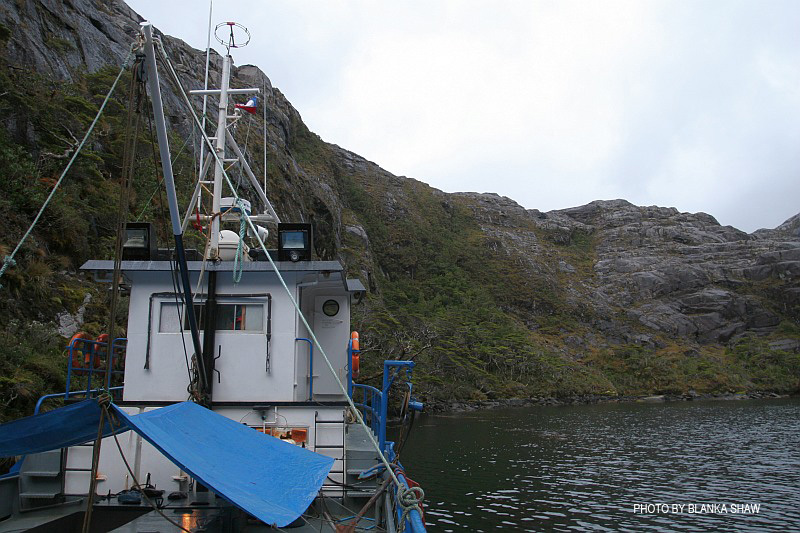 I finally saw Blanka on a slope below me and I called to her to come up to where I was. Like me before her, she looked pretty miserable, at least until she got to the cliff base. Instantly her excitement grew as she found liverworts she hadn’t been seeing elsewhere. Quite quickly, Blanka’s promise of only staying there for 10 minutes grew to over 30 minutes. Ultimately, we had to leave to get down to the shore, far below, for our scheduled rendezvous with the zodiac. We were the last to get back to the ship and so the engine room, where we hang wet clothing to dry, was already packed. However, having this space to dry clothing is a godsend; in only a few hours the wettest piece of clothing is dry and warm.
I finally saw Blanka on a slope below me and I called to her to come up to where I was. Like me before her, she looked pretty miserable, at least until she got to the cliff base. Instantly her excitement grew as she found liverworts she hadn’t been seeing elsewhere. Quite quickly, Blanka’s promise of only staying there for 10 minutes grew to over 30 minutes. Ultimately, we had to leave to get down to the shore, far below, for our scheduled rendezvous with the zodiac. We were the last to get back to the ship and so the engine room, where we hang wet clothing to dry, was already packed. However, having this space to dry clothing is a godsend; in only a few hours the wettest piece of clothing is dry and warm.
Bill's worst fear comes true. It's time to lunch on kelp soup!
Posted in Bill Buck, From the Field, Science on February 12 2011, by William R. Buck
Ed. note: NYBG scientist and Mary Flagler Cary Curator of Botany, Bill Buck is currently on expedition to the islands off Cape Horn, the southernmost point in South America, to study mosses and lichens. Follow his journeys on Plant Talk.
February 4, 2011; unnamed sound directly east of Seno Mama, 54°35’S, 71°34’W
 Yesterday was a busy day and I didn’t finish working on my specimens until 10:30 p.m., at which time I just wanted to hit my bunk, not my notebook! The day before yesterday we worked in a beautiful wet forest and we all collected lots of specimens, almost all of which were saturated with water. Not surprisingly, we’re baling in more collections than our drying system can handle, especially with five bryologists in the field. Most collections take about two days to dry on the lowest rack and longer on the upper shelves. At this point we all have wet specimens awaiting dryer space. And it certainly didn’t help that I made almost 100 collections yesterday.
Yesterday was a busy day and I didn’t finish working on my specimens until 10:30 p.m., at which time I just wanted to hit my bunk, not my notebook! The day before yesterday we worked in a beautiful wet forest and we all collected lots of specimens, almost all of which were saturated with water. Not surprisingly, we’re baling in more collections than our drying system can handle, especially with five bryologists in the field. Most collections take about two days to dry on the lowest rack and longer on the upper shelves. At this point we all have wet specimens awaiting dryer space. And it certainly didn’t help that I made almost 100 collections yesterday.
After awhile I am sure that all these places are starting to sound the same to you, especially since you are not here.  Quite honestly, at this point, many of our sites are even beginning to merge in my mind. I can distinctly remember the moment when I collected a moss and what the microhabitat looked like, but on which island or in which sound I found it is another story entirely. I assume that this will only get worse in the upcoming days because we are now hitting various sounds that go into the southern shore of Isla Grande (i.e., the large island) of Tierra del Fuego.
Quite honestly, at this point, many of our sites are even beginning to merge in my mind. I can distinctly remember the moment when I collected a moss and what the microhabitat looked like, but on which island or in which sound I found it is another story entirely. I assume that this will only get worse in the upcoming days because we are now hitting various sounds that go into the southern shore of Isla Grande (i.e., the large island) of Tierra del Fuego.
 Yesterday afternoon we stopped at our final two small islands. We anchored in the canal separating Isla Brecknock from Isla Macías. The last time we divided our group between two islands Jim felt he got the less interesting island and so this time I let him pick first. He and Matt chose Isla Brecknock because it is the larger of the two islands and had a nice waterfall descending near where we were. Blanka, Kimmy, and I took Isla Macías.
Yesterday afternoon we stopped at our final two small islands. We anchored in the canal separating Isla Brecknock from Isla Macías. The last time we divided our group between two islands Jim felt he got the less interesting island and so this time I let him pick first. He and Matt chose Isla Brecknock because it is the larger of the two islands and had a nice waterfall descending near where we were. Blanka, Kimmy, and I took Isla Macías.
Get a lesson on how to move through a fairy tale forest below.
Posted in Bill Buck, From the Field, Science on February 11 2011, by William R. Buck
Ed. note: NYBG scientist and Mary Flagler Cary Curator of Botany, Bill Buck is currently on expedition to the islands off Cape Horn, the southernmost point in South America, to study mosses and lichens. Follow his journeys on Plant Talk.
February 2, 2011; Seno Courtenay, northern arm, 54°30’S, 71°20’W
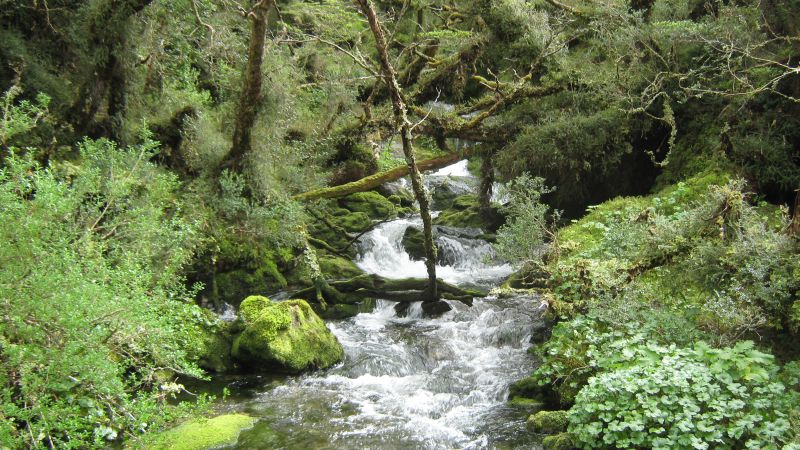 With today came the realization that the days are racing by. Initially it seemed like we had lots of time, but now the calendar is creeping up on us. We have today and the next three days before we head back to Punta Arenas (about a 17 hour trip).
With today came the realization that the days are racing by. Initially it seemed like we had lots of time, but now the calendar is creeping up on us. We have today and the next three days before we head back to Punta Arenas (about a 17 hour trip).
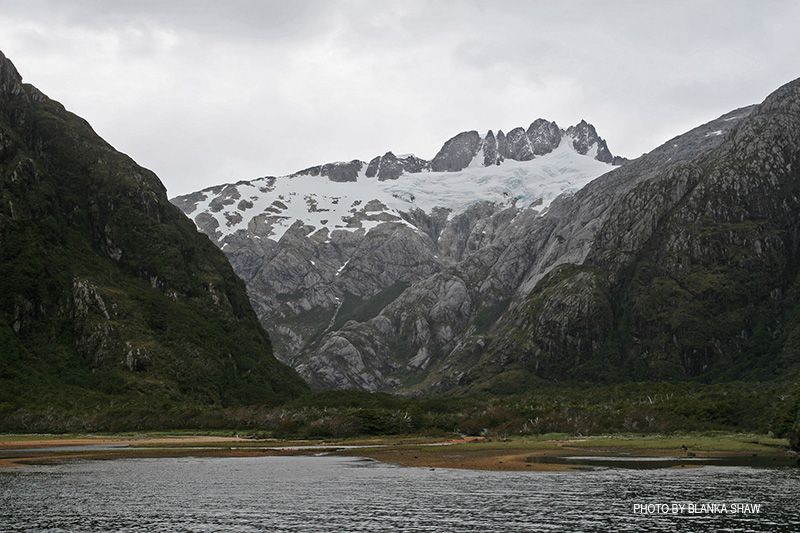 Today was a great collecting day, we all came back delighted with what we had found. Blanka has nicknamed this locality The Enchanted Forest. We are in an eastern arm of Seno Courtenay where several small rivers emerge from what looks like a floodplain forest. There is supposedly a glacier-fed lake upriver, but not one of us has made it that far! At the beginning of the morning I was disappointed when I entered the forest; it seemed like it contained only the standard mosses I have become used to seeing.
Today was a great collecting day, we all came back delighted with what we had found. Blanka has nicknamed this locality The Enchanted Forest. We are in an eastern arm of Seno Courtenay where several small rivers emerge from what looks like a floodplain forest. There is supposedly a glacier-fed lake upriver, but not one of us has made it that far! At the beginning of the morning I was disappointed when I entered the forest; it seemed like it contained only the standard mosses I have become used to seeing. 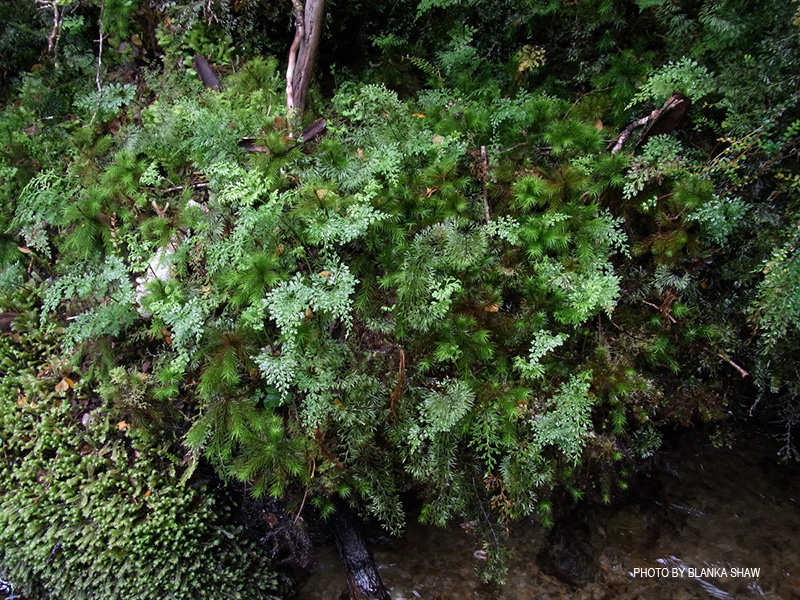 However, as I worked through the forest, the humidity increased as did the number and biomass of epiphytes. The trunks and branches of most trees were sheathed in bryophytes, and even twig epiphytes increased in diversity.
However, as I worked through the forest, the humidity increased as did the number and biomass of epiphytes. The trunks and branches of most trees were sheathed in bryophytes, and even twig epiphytes increased in diversity.
More from The Enchanted Forest below.
Posted in Bill Buck, From the Field, Science on February 10 2011, by William R. Buck
Ed. note: NYBG scientist and Mary Flagler Cary Curator of Botany, Bill Buck is currently on expedition to the islands off Cape Horn, the southernmost point in South America, to study mosses and lichens. Follow his journeys on Plant Talk.
February 1, 2011; Seno Courtenay, 54°37’S, 71°21’W
 The ship engines started about 6:30 a.m. By this point in our journey, this rouses no one from their bunks except the crew. However, as soon as the engines are cut off it means we have arrived at our next field site and everyone hurries up to breakfast. Every morning for breakfast there is fresh bread, sometimes baked, sometimes fried. It’s a great way to start the day.
The ship engines started about 6:30 a.m. By this point in our journey, this rouses no one from their bunks except the crew. However, as soon as the engines are cut off it means we have arrived at our next field site and everyone hurries up to breakfast. Every morning for breakfast there is fresh bread, sometimes baked, sometimes fried. It’s a great way to start the day.
 Mornings are mostly proving to have reasonable weather, but usually by 1-2 p.m. it starts to rain harder and the winds pick up. This morning we arrived in Bahía Murray on the east side of Isla Basket. The island is named for Fuegia Basket, the name Charles Darwin’s expedition gave to an indigenous young woman that they essentially kidnapped and took to England to “civilize.” The weather–just light continuous drizzle–was not an issue, and we all went ashore to collect. We split into a few groups to cover more habitats. Juan decided to try and reach a peak that rises to about 1600-1700 feet and took our satellite modem with him in an attempt to send out my daily blogs. He got within 50 feet of the summit but couldn’t continue because the rocks were steep and crumbling. Needless to say, the modem still couldn’t find a satellite.
Mornings are mostly proving to have reasonable weather, but usually by 1-2 p.m. it starts to rain harder and the winds pick up. This morning we arrived in Bahía Murray on the east side of Isla Basket. The island is named for Fuegia Basket, the name Charles Darwin’s expedition gave to an indigenous young woman that they essentially kidnapped and took to England to “civilize.” The weather–just light continuous drizzle–was not an issue, and we all went ashore to collect. We split into a few groups to cover more habitats. Juan decided to try and reach a peak that rises to about 1600-1700 feet and took our satellite modem with him in an attempt to send out my daily blogs. He got within 50 feet of the summit but couldn’t continue because the rocks were steep and crumbling. Needless to say, the modem still couldn’t find a satellite.
Scientists at work! More below.
Posted in Bill Buck, From the Field, Science on February 9 2011, by William R. Buck
Ed. note: NYBG scientist and Mary Flagler Cary Curator of Botany, Bill Buck is currently on expedition to the islands off Cape Horn, the southernmost point in South America, to study mosses and lichens. Follow his journeys on Plant Talk.
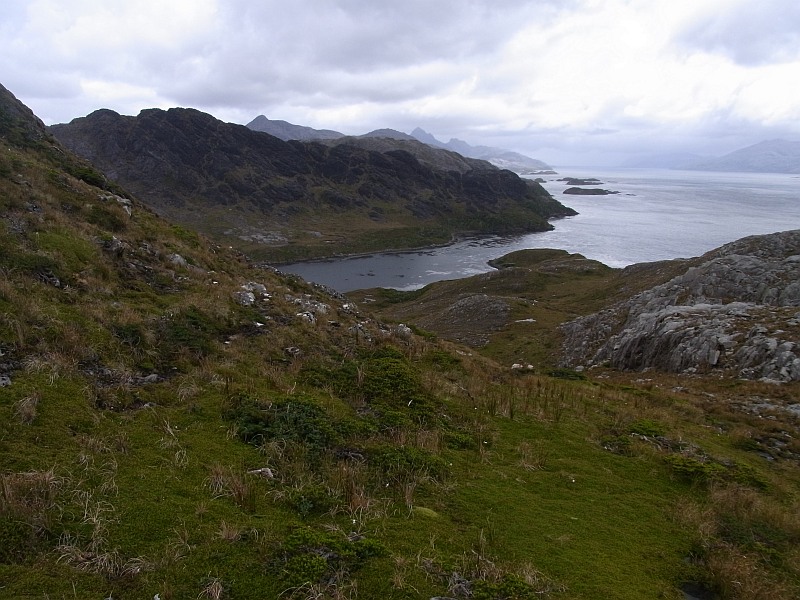 January 31, 2011; canal between Isla Georgiana and Isla Clementina, 54°41’S, 71°45’W
January 31, 2011; canal between Isla Georgiana and Isla Clementina, 54°41’S, 71°45’W
The engines started early and we only traveled about 1 1/2 hours before they stopped again. Because of the short time I assumed that we must have just headed north to the Brecknock Peninsula. However, much to my delight we were actually in a small sound on the northwest side of Isla Sidney. The gods must have been smiling on us, because for one of these barrier islands, the weather was great. The sun came and went, and only an occasional shower passed. This was particularly surprising because as we were getting into our rain gear before leaving the ship it had been sleeting.
 We split into three groups and headed off in different directions. I went alone to a beautiful southern beech gallery forest along a small, rocky steam. As I worked up the stream it eventually opened up and the rocks in the stream changed from being liverwort-covered in the shade, to moss-covered in the sun. As much as I am enjoying the company of my colleagues, it was nice to be alone for a few hours, especially in such a beautiful place. When we returned to our pick-up point in the early afternoon, everyone was very pleased both with what they had found, as well as with the weather (especially after the previous day).
We split into three groups and headed off in different directions. I went alone to a beautiful southern beech gallery forest along a small, rocky steam. As I worked up the stream it eventually opened up and the rocks in the stream changed from being liverwort-covered in the shade, to moss-covered in the sun. As much as I am enjoying the company of my colleagues, it was nice to be alone for a few hours, especially in such a beautiful place. When we returned to our pick-up point in the early afternoon, everyone was very pleased both with what they had found, as well as with the weather (especially after the previous day).
The team hits the bryophyte jackpot! More below.
Posted in Bill Buck, From the Field, Science on February 8 2011, by William R. Buck
Ed. note: NYBG scientist and Mary Flagler Cary Curator of Botany, Bill Buck is currently on expedition to the islands off Cape Horn, the southernmost point in South America, to study mosses and lichens. Follow his journeys on Plant Talk.
 January 30, 2011; Unnamed sound on south side of Brecknock Peninsula, NW of Isla Georgiana, 54°36’S, 71°49’W
January 30, 2011; Unnamed sound on south side of Brecknock Peninsula, NW of Isla Georgiana, 54°36’S, 71°49’W
Early in the morning the crew moved the ship to a harbor on the northeast side of Isla London, one of the islands in direct contact with the weather from Antarctica. After two days of glorious weather, Matt was beginning to wonder if the weather I had told him to prepare for was just a myth. He soon found out how true my warnings had been. The morning started out a bit windy and overcast, but without rain. 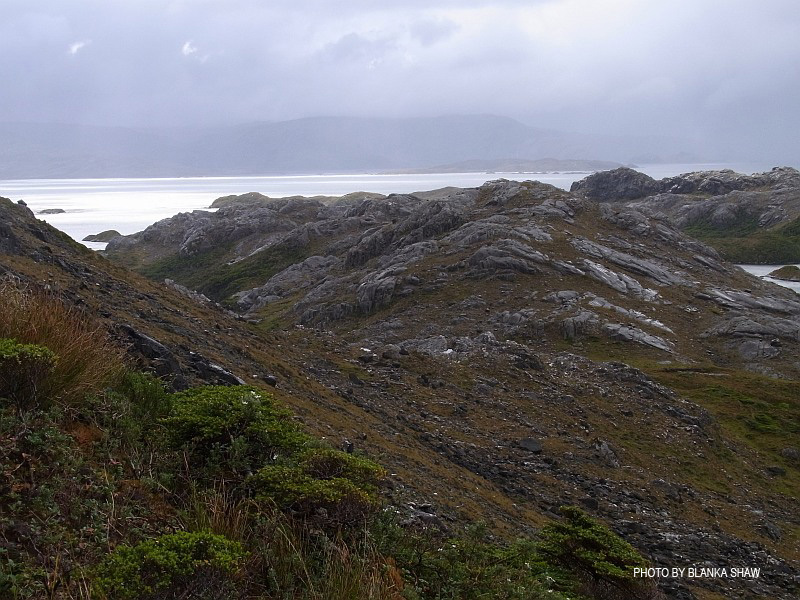 One group set out to with the intention of ascending Horatio Peak, while Blanka and I headed to a rocky outcrop in the opposite direction. As the zodiac neared the shore the wind started to pick up, and soon became a strong steady wind came out of the southwest, gusting so hard at times to literally blow me off my feet. Fortunately, as we worked up the slope the wind was at our backs and helped propel us as we scrambled over the vegetation, walking on top of the canopy of dwarf beeches as on the previous morning.
One group set out to with the intention of ascending Horatio Peak, while Blanka and I headed to a rocky outcrop in the opposite direction. As the zodiac neared the shore the wind started to pick up, and soon became a strong steady wind came out of the southwest, gusting so hard at times to literally blow me off my feet. Fortunately, as we worked up the slope the wind was at our backs and helped propel us as we scrambled over the vegetation, walking on top of the canopy of dwarf beeches as on the previous morning.
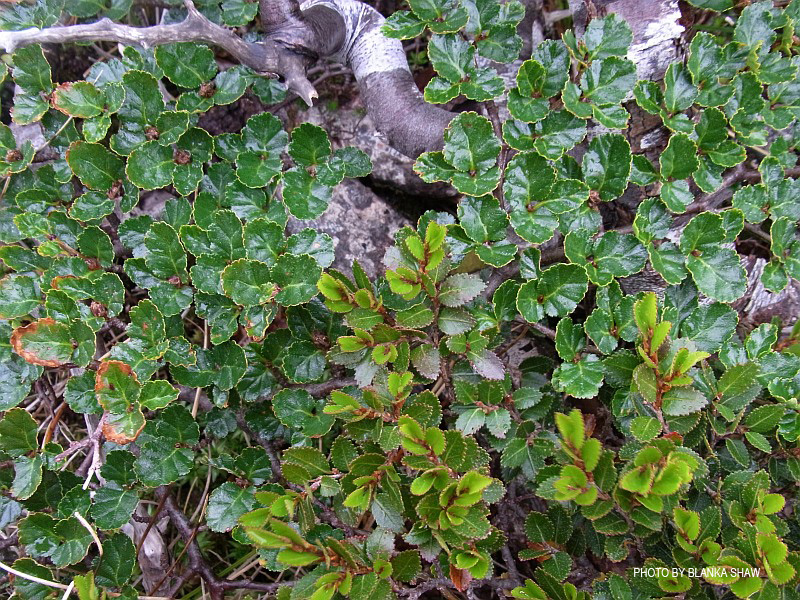 In short order, though, a heavy, horizontal, rain began. I had become separated from Blanka, all I could do was hope that she was able to find shelter. (I later discovered she had also tried to find me to let me know she was fine). On the side of a ridge I plopped down and sank into the shrubs; I was completely below the surface of the dwarf tree canopy, but could see out. The rain blew in sheets as spray from the sea was whipped up and blown ashore. The water dripping down my face tasted salty. Because of the high winds, it was too dangerous to walk around. For about a half an hour I remained immersed in the shrubs and watched as the rain and wind blasted the island. I was glad I was not up on an exposed ridge like the other group, and hoped they had found shelter. After some time, the winds became less gusty and died down, and the rain softened so that it no longer felt like pellets as it hit my skin.
In short order, though, a heavy, horizontal, rain began. I had become separated from Blanka, all I could do was hope that she was able to find shelter. (I later discovered she had also tried to find me to let me know she was fine). On the side of a ridge I plopped down and sank into the shrubs; I was completely below the surface of the dwarf tree canopy, but could see out. The rain blew in sheets as spray from the sea was whipped up and blown ashore. The water dripping down my face tasted salty. Because of the high winds, it was too dangerous to walk around. For about a half an hour I remained immersed in the shrubs and watched as the rain and wind blasted the island. I was glad I was not up on an exposed ridge like the other group, and hoped they had found shelter. After some time, the winds became less gusty and died down, and the rain softened so that it no longer felt like pellets as it hit my skin.
Meet the rest of the crew below!
Posted in Bill Buck, From the Field, Science on February 7 2011, by William R. Buck
Ed. note: NYBG scientist and Mary Flagler Cary Curator of Botany, Bill Buck is currently on expedition to the islands off Cape Horn, the southernmost point in South America, to study mosses and lichens. Follow his journeys on Plant Talk.
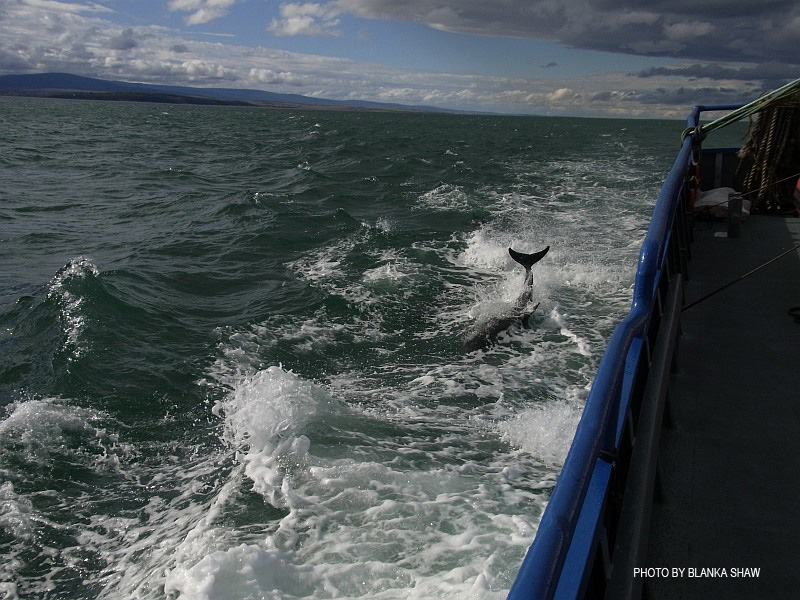 January 29, 2011; Isla Aguirre, Seno Quo Vadis, 54°34’S, 71°59’W
January 29, 2011; Isla Aguirre, Seno Quo Vadis, 54°34’S, 71°59’W
Our two days in Punta Arenas seemed to drag on after such a great first part of our expedition. However, it did mean we were able to pick up Matt and buy a few things to tweak the moss dryers. On the morning of January 28 we returned to the port to board our trusty ship. Going out onto the dock, the ship, which was sandwiched between a large naval vessel and a massive cruise ship, looked even smaller. A number of the passengers disembarking from the cruise ship stopped and asked what we were doing. As soon as I hear an American accent I tell them “Your tax dollars at work!” and briefly explain the project. I think it is important for them to know that their taxes pay for something more than war.
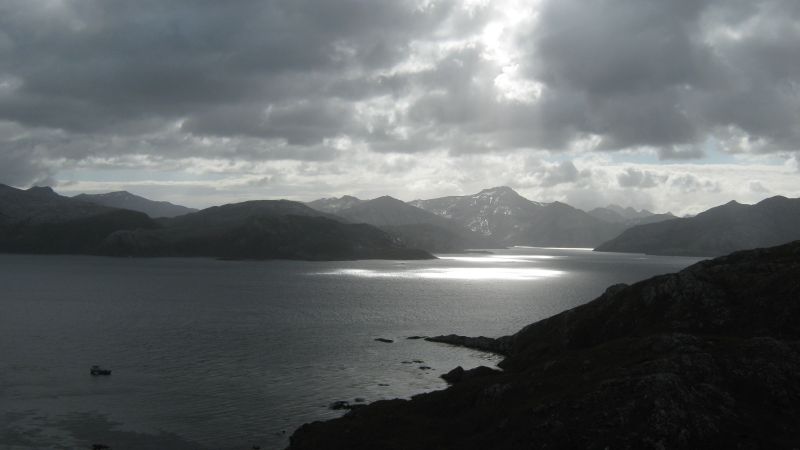 Shortly after we untied from the dock and headed south, once again motoring through the Straits of Magellan, a pod of at least ten dolphins joined our ship. They criss-crossed in front of our ship for over an hour, seemingly doomed to a collision which never came. The same time the sea was remarkably calm; even in canals where we had previously encountered violent water, the ship hardly rocked. The captain chose to take an inland passage rather than the more commonly used Cockburn Canal. We seemed, time and again, to enter into a dead end sound, only at the last minute to watch it turn into a previously invisible sound. A short time later the passage we had just come from had similarly disappeared. Going down these narrow waterways, as opposed to wide canals, gave us a better view of the incredible forests that march up the shores. Although continuously overcast, the evening light was almost luminescent and navigating through a veritable maze of islands was a special experience. Once again I delighted in Matt’s reaction to the astounding landscapes, as I had with the others in our group the previous week.
Shortly after we untied from the dock and headed south, once again motoring through the Straits of Magellan, a pod of at least ten dolphins joined our ship. They criss-crossed in front of our ship for over an hour, seemingly doomed to a collision which never came. The same time the sea was remarkably calm; even in canals where we had previously encountered violent water, the ship hardly rocked. The captain chose to take an inland passage rather than the more commonly used Cockburn Canal. We seemed, time and again, to enter into a dead end sound, only at the last minute to watch it turn into a previously invisible sound. A short time later the passage we had just come from had similarly disappeared. Going down these narrow waterways, as opposed to wide canals, gave us a better view of the incredible forests that march up the shores. Although continuously overcast, the evening light was almost luminescent and navigating through a veritable maze of islands was a special experience. Once again I delighted in Matt’s reaction to the astounding landscapes, as I had with the others in our group the previous week.
 Before going to bed I spoke with the captain and explained the area we wished to cover and told him that it was his decision, based on navigability and weather, as to where we started. If we had relatively good weather, we would stop at the westernmost islands south of the Brecknock Peninsula; or if the weather looked bad, we would go to the eastern end of the area where sheltered sounds would allow us to still work. The far western islands have proven tricky in previous trips where it rained hard and incessantly with fog drifting across the area making it unsafe to get far from the ship. These islands have no land between them and Antarctica. However, it is this very climate–as harsh as it may seem when we are out collecting–that may well be encouraging the growth of mosses that we do not otherwise see in our region. During the night, most of us awoke as the ship hit rough waters and was buffeted about as we rounded the Brecknock Peninsula in seas open to Antarctic winds and storms. In the middle of the night, it almost seemed dreamlike.
Before going to bed I spoke with the captain and explained the area we wished to cover and told him that it was his decision, based on navigability and weather, as to where we started. If we had relatively good weather, we would stop at the westernmost islands south of the Brecknock Peninsula; or if the weather looked bad, we would go to the eastern end of the area where sheltered sounds would allow us to still work. The far western islands have proven tricky in previous trips where it rained hard and incessantly with fog drifting across the area making it unsafe to get far from the ship. These islands have no land between them and Antarctica. However, it is this very climate–as harsh as it may seem when we are out collecting–that may well be encouraging the growth of mosses that we do not otherwise see in our region. During the night, most of us awoke as the ship hit rough waters and was buffeted about as we rounded the Brecknock Peninsula in seas open to Antarctic winds and storms. In the middle of the night, it almost seemed dreamlike.
Bill Buck and his colleagues find themselves in a world of miniature trees. Read more below.
Posted in Bill Buck, From the Field, Science on February 1 2011, by William R. Buck
Ed. note: NYBG scientist and Mary Flagler Cary Curator of Botany, Bill Buck is currently on expedition to the islands off Cape Horn, the southernmost point in South America, to study mosses and lichens. Follow his journeys on Plant Talk.
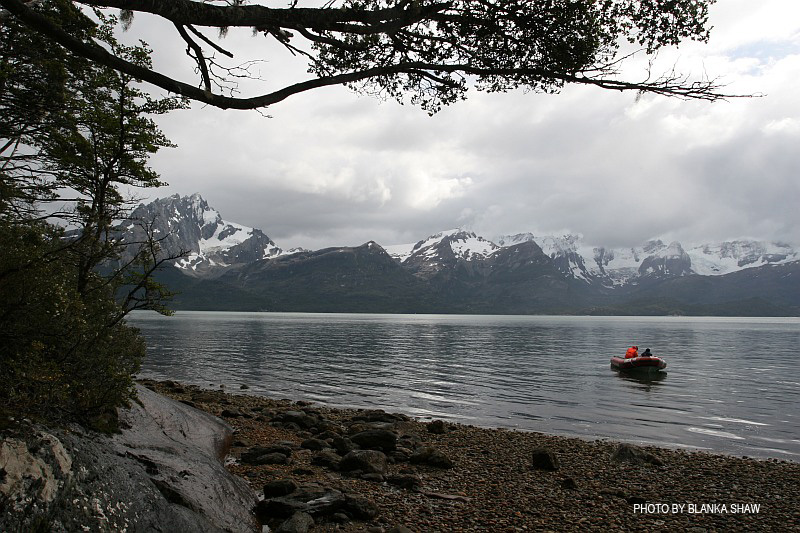 January 26, 2011, Punta Arenas, Chile
January 26, 2011, Punta Arenas, Chile
We awoke on the morning of January 25 in Seno Agostini, having arrived there at about 4 a.m. Initially the journey was rough because of strong winds and large swells. Standing on the deck, but huddled close to the cabin, I was in awe of the weather. Since childhood in Florida, the U.S. capital of lightning, I have loved violent weather. On this day, the wind howled and the boat was tossed and turned by the rough seas; every few seconds waves would crash over the deck. To be on a small ship amidst such weather is amazing. Of course it helps to have a ship that you have faith in and a reliable crew. A few of our group felt a bit queasy, but no real problems came up (pun intended). After about an hour and a half we entered a narrower channel and the seas were calmer. Only then was dinner served.
Coming out on deck the next morning the scenery was spectacular. We had come to this spot because in 1929 a Finnish bryologist, Heiki Roivainen, visited the site and, in an alpine stream, collected a moss that has not been found since. Because this is a moss that is part of Juan’s doctoral work, he was anxious to find it again. The site is called Mt. Buckland, and it rises to over 6,000 feet but is mostly snow-covered above. Supposedly the moss was collected at about 2,000 feet in an alpine stream. All around us rugged peaks rose to the sky, all with either snow or glaciers. At least for a short time the sun shone brightly.
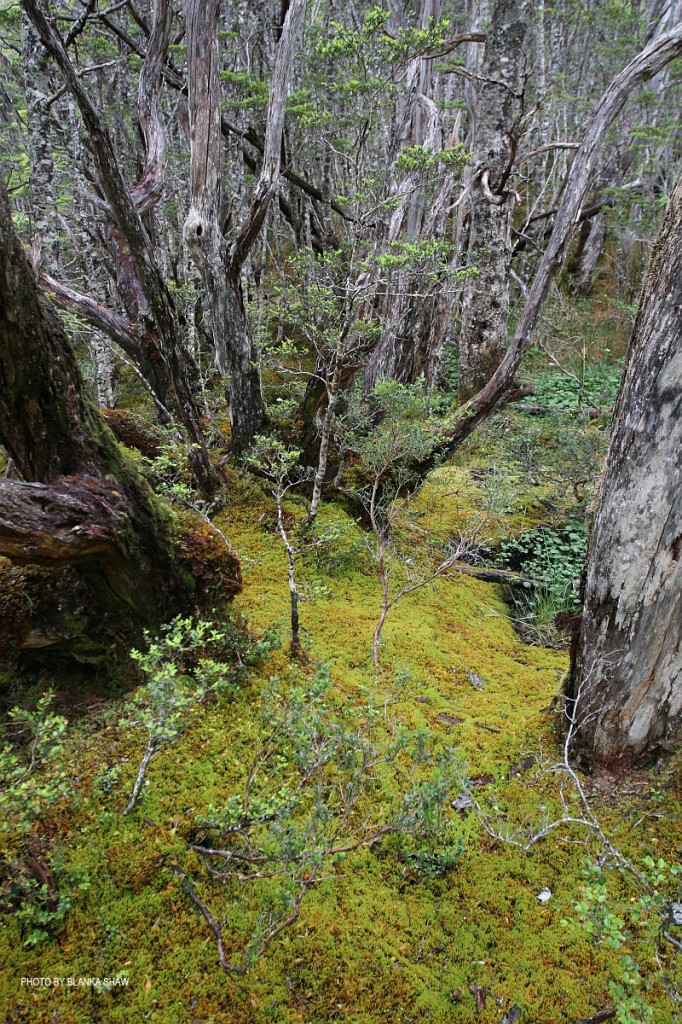 So, optimistically, Jim and Juan headed up the slopes of Mt. Buckland. Blanka and I chose to visit a southern beech forest on the other side of the sound that had a large glacier at its back side. It was about a 20 minute zodiac ride across the sound but as soon as we hit the rocky beach we knew we were in a special place. Numerous small, glacier-fed streams wound their way through the landscape and occasional large rock outcrops promised multiple microhabitats for bryophytes. Once Blanka entered the forest, about 10 yards past the coastal scrub, it took me about an hour to get her to move ahead. The forest floor was carpeted with a thick layer of liverworts that swallowed our boots with every step. Trees were sheathed with bryophytes and lichens, often several times the diameter of the trunks themselves. We worked our way through the forest toward the glacier, marveling at the diversity and sheer biomass of bryophytes in the forest.
So, optimistically, Jim and Juan headed up the slopes of Mt. Buckland. Blanka and I chose to visit a southern beech forest on the other side of the sound that had a large glacier at its back side. It was about a 20 minute zodiac ride across the sound but as soon as we hit the rocky beach we knew we were in a special place. Numerous small, glacier-fed streams wound their way through the landscape and occasional large rock outcrops promised multiple microhabitats for bryophytes. Once Blanka entered the forest, about 10 yards past the coastal scrub, it took me about an hour to get her to move ahead. The forest floor was carpeted with a thick layer of liverworts that swallowed our boots with every step. Trees were sheathed with bryophytes and lichens, often several times the diameter of the trunks themselves. We worked our way through the forest toward the glacier, marveling at the diversity and sheer biomass of bryophytes in the forest.
Barberries, bryophytes, and icebergs, oh my! More below.
Posted in Bill Buck, From the Field, Science on January 31 2011, by William R. Buck
Ed. note: NYBG scientist and Mary Flagler Cary Curator of Botany, Bill Buck is currently on expedition to the islands off Cape Horn, the southernmost point in South America, to study mosses and lichens. Follow his journeys on Plant Talk.
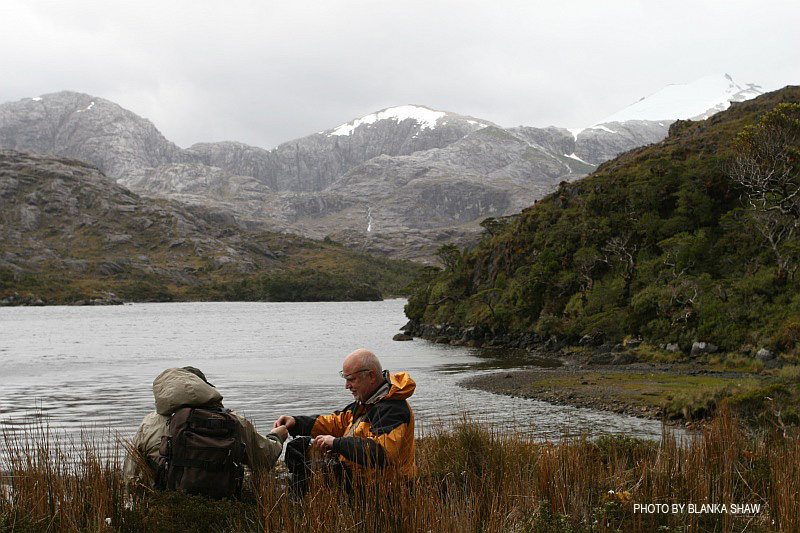 January 24, 2011, Seno Chasco, just north of isthmus to Brecknock Peninsula, Chile, 54° 34’S, 71° 39’W
January 24, 2011, Seno Chasco, just north of isthmus to Brecknock Peninsula, Chile, 54° 34’S, 71° 39’W
Last night, after I had finished my work for the day, I was enjoying the night out on the deck (i.e., a lull in the rain) and watching Blanka, Jim and Juan down in the hold putting their collections on the dryer. They have each been consistently excited about going out into the field everyday, no matter what the weather. Back on the ship they happily go through their collections. Watching their interest and energy makes me feel good that I am able to provide them with this opportunity. It also gives me something to look forward to, for those future expeditions when, in upcoming years, new teams of bryologists will accompany me to this spectacular region. Although it is something that never occurred to me before, this truly is one of the highlights of this project, being able to see the excitement on the faces of bryologists who have never seen such a mossy paradise before, and knowing that I could give them this gift (thanks to the National Science Foundation).
More on Cape Horn's mossy paradise below.

 February 8, 2011; Punta Arenas, Chile; final entry
February 8, 2011; Punta Arenas, Chile; final entry The ship was tied to a rock wall and we were able to just jump ashore and begin our collecting. The destination-oriented collectors ran ahead in an attempt to reach a nearby rocky peak. Apparently in these exposed areas the wind was fierce and prevented much progress. On the other hand, Kimmy and I hadn’t made it far from the ship when I spotted a steep ravine that ran right down the sea (which the others had run past). It was wet and slippery, but it’s always harder going down than climbing up, so we decided to chance it. At times I had to remove my collecting pack and leave it behind in order to fit onto narrow ledges that I wanted to access. In the end my efforts were rewarded with a moss no one on our ship recognized. Having to crawl backwards to get off the ledge was a small price to pay.
The ship was tied to a rock wall and we were able to just jump ashore and begin our collecting. The destination-oriented collectors ran ahead in an attempt to reach a nearby rocky peak. Apparently in these exposed areas the wind was fierce and prevented much progress. On the other hand, Kimmy and I hadn’t made it far from the ship when I spotted a steep ravine that ran right down the sea (which the others had run past). It was wet and slippery, but it’s always harder going down than climbing up, so we decided to chance it. At times I had to remove my collecting pack and leave it behind in order to fit onto narrow ledges that I wanted to access. In the end my efforts were rewarded with a moss no one on our ship recognized. Having to crawl backwards to get off the ledge was a small price to pay.





















